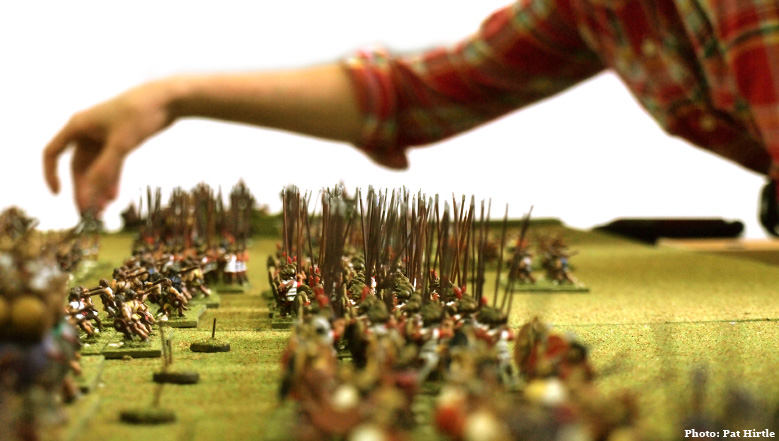SP came over last night for the second iteration of our Washbourn Trophy Lost Battles series. I had set the battle as Gaza 312 BC, for its ease of set up (only a flat plain to fight over) when time was short, and for its own sake.
I don't recall having fought it before - though surely I must have - so we were both going in without too many preconceived ideas of how to play the scenario. Being on holiday this week, SP had the day to come up with a strategy, while I would rely upon my knowledge of the rules and 'general tactical nous' to breeze through.
The first point of interest is the armies. Both are successor forces led by fighting generals - Ptolemy/Seleucus (combined into a single on-table commander) the one and Demetrius the other - with the usual mix of phalangites and cavalry heavy and light. In addition Demetrius had three units of elephants, and Ptolemy a dedicated anti-elephant corps of light infantry, in four units.
Essentially, it was to be a battle of elephants vs light infantry, phalanx vs phalanx, cavalry vs cavalry, and inspired commander (Ptolemy) vs average commander (Demetrius).
In fighting value Ptolemy had the edge 79 points to 67, but it was still close enough to be challenging for both sides.
We used the historical deployments outlined in Phil Sabin's Lost Battles book, so the action began for us in turn two.
As Demetrius, and with the first move, I attacked on my left with Demetrius himself and his two units of veteran heavy cavalry. I then reinforced this zone with light cavalry from my right flank, bringing them around behind my army to give some extra numbers in what was bound to be a tough fight on the left. My centre left attacked with elephants in the lead, and I advanced in the centre to allow the light cavalry to scoot around behind them in the aforementioned reinforcement move. My right - now my weakest zone - I refused.
As Ptolemy, SP fought fire with fire on his right. He attacked with bravado with his two veteran heavy cavalry units and light cavalry, and then also reinforced this zone with cavalry from elsewhere in his army. His light infantry hit my elephants hard, and rather than advance his centre and left he merely redeployed his leftmost unit of light cavalry so that they could reinforce Ptolemy next turn if needed.
Turn four saw Demetrius shatter a unit of light cavalry in Ptolemy's zone, but the rest of his army held firm. There was little success elsewhere.
 |
| The view from Demetrius's zone after his second attack. Note his position in the lead with his guard cavalry in an attempt to shatter the enemy zone before it can be reinforced. It was not to be! |
Ptolemy reinforced his own zone again with more light cavalry, and fought back with determination. He scored two hits with the cavalry in his zone, and then three hits against Demetrius's centre left as the elephants panicked in the face of the light infantry assault.
 |
| Again from Demetrius's zone: a violence of horses, and some reinforcements. |
Two more turns went by with some thrilling exchanges as both sides fought desperately to win the cavalry fight between the two opposed generals. The full complement of Lost Battles's tactical tricks was employed, to our delight: manipulation of lead units to maximise attack and best defend; command bonuses artfully issued; Favour of the Gods re-rolls demanded; generals rallying what could have been battle-defining strikes.
Elsewhere the elephants continue to panic, and the phalanxes engaged in the centre. My men all-out-attacked in an effort to make the enemy army as vulnerable as possible to mass rout once the moment came.
The moment, however, did not come. A shatter, a double shatter, a successful rout test, a shatter, a failed rout test, and Demetrius was alone with his guard cavalry.
 |
| The grim reality: Demetrius about to be permanently displaced. |
Demetrius's guard was destroyed, and the man himself fled the field. He took the centre left with him in a trumpeting of panicked elephants and a cacaphony of hooves.
In the centre, the phalanx turned and pulled back, marching off table to escape with what they could.
Battle over, and Ptolemy was victorious 93 points to 74. The result did not show how closely fought it was. In the aftermath, we were pleased to announce that SP had won the Washbourn Trophy. It would change hands and go home with him.
We still had time for a second battle, so we set up again. This one was also a tough fight in which we put hard-learned lessons from the first battle to good use.
The action on my left played out much as before, with our cavalry wing and elephant-led left-centre eventually losing against Ptolemy, but this time we were a lot more active with our centre and right wing. Even after our left routed, our right fought on, up until the tenth turn, shattering enemy before eventually, just a moment before darkness fell, being shattered ourselves.
 |
| Game two, three turns in. |
The final result was 100-99, with SP as Ptolemy again emerging the victor! We were both a little surprised with this result. I thought I had done enough to win on points under the Lost Battles handicap system, but not quite.
Again Lost Battles delivered. Two exciting games which could have gone to either side, with two very plausable results which did no injustice to history.
Thanks to SP - worthy winner of the Washbourn Trophy - and to Phil Sabin, master rules designer!
And if you ask for Demetrius now? You will find him eyeless in Gaza at the mill among slaves.























